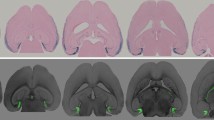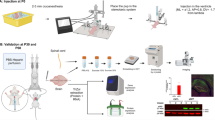Abstract
Transgenic mouse lines were generated that expressed a 2-kb amyloid precursor protein (APP) promoter/β-galactosidase reporter gene construction. In brain, hippocampal pyramidal neurons, neurons in the deeper layers of cerebral cortex, and neurons in several thalamic nuclei were heavily labeled by β-galactosidase histochemistry. In general, molecular layers and white matter regions did not express the reporter gene. When compared with in situ hybridization for endogenous murine APP RNA, the striatum and outer layers of cerebral cortex had little reporter expression. Thus, the match between reporter expression and endogenous APP expression in brain was not perfect. A similar mismatch between the relative expression of the reporter gene and endogenous APP RNA distribution was found in homogenates from several organs. Although prior work in transgenic mice found similar mismatches in reporter gene distribution, none had tested the APP promoter construct in response to neuronal injury. Kainic acid injections successfully increased murine APP expression in the transgenic mice, but had no effect on the reporter gene expression. Based on these data and those collected by others, we conclude that the 2-kb region upstream of the APP transcription initiation site contains some elements responsible for the tissue-specific expression of this gene, but does not contain all the cis-acting elements sufficient for either the differential tissue distribution of this gene or the regulation of this gene subsequent to neural damage.
Similar content being viewed by others
References
Banati R. B., Gehrmann J., Wiessner C., Hossman K. A., and Kreutzberg G. W. (1995) Glial expression of the beta-amyloid precursor protein (APP) in global ischemia. J. Cerb. Blood Flow Met. 15(4), 647–654.
Buxbaum J. D., Christensen J. L., Ruefli A. A., Greengard P., and Loring J. F. (1993) Expression of APP in brains of transgenic mice containing the entire human APP gene. Biochem. Biophys. Res. Commun. 197(2), 639–645.
Fidani L., Rooke K., Chartier-Harlin M.-C., Hughes D., Tanzi R., Roques P., et al. (1992) Screening for mutations in the open reading frame and promoter of the beta-amyloid precursor protein gene in familial Alzheimer’s disease: identification of a further family with APP717 Val-IIe. Hum. Mol. Genet. 1, 165–168.
Fox N. W., Johnstone E. M., Ward K. E., Schrementi J., and Little S. P. (1997) APP gene promoter constructs are preferentially expressed in the CNS and testis of transgenic mice. Biochem. Biophys. Res. Commun. 240(3), 759–762.
Games D., Adams D., Alessandrini R., Barbour R., Berthelette P., Blackwell C., et al. (1995) Alzheimertype neuropathology in transgenic mice over-expressing V717F beta-amyloid precursor protein. Nature 373, 523–527.
Gordon M. N., Schreier W. A., Ou X., Holcomb L. A., and Morgan D. G. (1997) Exaggerated astrocyte reactivity after nigrostriatal deafferentation in the aged rat. J. Comp. Neurol. 388, 106–119.
Goss J. R. and Morgan D. G. (1995) Enhanced glial fibrillary acidic protein RNA response to fornix transection in aged mice. J. Neurochem. 64, 1351–1360.
Griffin W. S., Sheng J. G., Gentleman S. M., Graham D. I., Mrak R. E., and Roberts G. W. (1994) Microglial interleukin-1 alpha expression in human head injury: correlations with neuronal and neuritic beta-amyloid precursor protein expression. Neurosci. Lett. 176, 133–136.
Hardy J. (1997) Amyloid, the presenilins and Alzheimer’s disease. Trends. Neurosci. 20, 154–160.
Hoffman P. W. and Chernak J. M. (1995) DNA binding and regulatory effects of transcription factors SP1 and USF at the rat amyloid precursor protein gene promoter. Nucleic Acids Res. 23(12), 2229–2235.
Hsiao K., Chapman P., Nilsen S., Eckman C., Harigaya Y., Younkin S., et al. (1996) Correlative memory deficits, Abeta elevation, and amyloid plaques in transgenic mice. Science 274, 99–102.
Kawarabayashi T., Shoji M., Harigaya Y., Yamaguchi H., and Hirai S. (1991) Expression of APP in the early stage of brain damage. Brain Res. 563, 334–338.
Kovacs D., Wasco W., Witherby J., Felsenstein K. M., Brunel F., Roeder R. G., et al. (1995) The upstream stimulatory factor functionally interacts with the Alzheimer amyloid beta-protein precursor gene. Hum. Mol. Genet. 4, 1527–1533.
La Fauci G., Lahiri D. K., Salton S. R. J., and Robakis N. K. (1989) Characterization of the 5′-end region and the first two exons of the beta-protein precursor gene. Biochem. Biophys. Res. Commun. 159, 297–304.
Lahiri D. K. and Nall C. (1995) Promoter activity of the gene encoding the beta-amyloid precursor protein is up-regulated by growth factors, phorbol ester, retinoic acid and interleukin-1. Mol. Brain Res. 32, 233–240.
Lamb B. T., Sisodia S. S., Lawler A. M., Slunt H. H., Kitt C. A., Kearns W. G., et al. (1993) Introduction and expression of the 400 kilobase amyloid precursor protein gene in transgenic mice. Nature Genet. 5, 22–30.
Lendon C. L., Ashall F., and Goate A. M. (1997) Exploring the etiology of Alzheimer disease using molecular genetics. JAMA 277, 825–831.
Manning R. W., Reid C. M., Lampe R. A., and Davis L. G. (1988) Identification in rodents and other species of an mRNA homologous to the human beta-amyloid precursor. Mol. Brain Res. 3, 293–298.
Neve R. L., Finch E. A., and Dawes L. R. (1988) Expression of the Alzheimer amyloid precursor gene transcripts in the human brain. Neuron 1, 669–677.
Pollwein P., Masters C. L., and Beyreuther K. (1992) The expression of the amyloid precursor protein (APP) is regulated by two GC-elements in the promoter. Nucleic Acids Res. 20, 63–68.
Quitschke W. W. and Goldgaber D. (1992) The amyloid beta-protein precursor promoter. A region essential for transcriptional activity contains a nuclear factor binding domain. J. Biol. Chem. 267, 17,362–17,368.
Ringheim G. E., Szcepanik A. M., Burgher K. L., Petko W., Heroux J. A., and Cavalieri F. (1996) Transcriptional inhibition of the beta-amyloid precursor protein by interferon-gamma. Biochem. Biophys. Res. Commun. 224(1), 246–251.
Salbaum J. M., Widemann A., Lemaire H. G., Masters C. L., and Beyreuther K. (1988) The promoter of Alzheimer’s disease amyloid A4 precursor gene. EMBO J. 7(9), 2807–2813.
Schauwecker P. E. and Steward O. (1997) Genetic determinants of susceptibility to excitotoxic cell death: implications for gene targeting approaches. Proc. Natl. Acad. Sci. USA 94, 4103–4108.
Siman R., Card J. P., Nelson R. B., and Davis L. G. (1989) Expression of beta-amyloid precursor protein in reactive astrocytes following neuronal damage. Neuron 3, 275–285.
Tanzi R. E., Gusella J. F., Watkins P. C., Bruns G. A. P., St. George-Hyslop P., van Keuren M. L., et al. (1987) Amyloid beta protein gene: cDNA, mRNA distribution, and genetic linkage near the Alzheimer locus. Science 235, 880–883.
Wirak D. O., Bayney R., Kundel C. A., Lee A., Scangos G. A., Trapp B. D., et al. (1991) Regulatory region of human amyloid precursor protein (APP) gene promotes neuron-specific gene expression in the CNS of transgenic mice. EMBO J. 10, 289–296.
Yamada T., Sasaki H., Furuya H., Miyata T., Goto I., and Sakaki Y. (1987) Complementary DNA for the mouse homolog of the human amyloid beta protein precursor. Biochem. Biophys. Res. Commun. 149, 665–671.
Author information
Authors and Affiliations
Rights and permissions
About this article
Cite this article
Wright, K.L., Morgan, D.G., Yu, X. et al. Mice transgenic for a human amyloid precursor protein promoter-lacZ reporter construct. J Mol Neurosci 13, 111–120 (1999). https://doi.org/10.1385/JMN:13:1-2:111
Issue Date:
DOI: https://doi.org/10.1385/JMN:13:1-2:111




